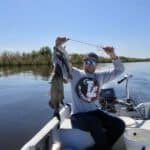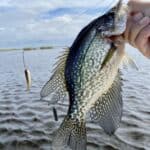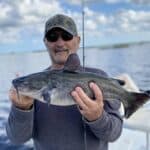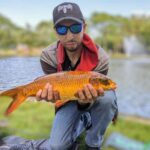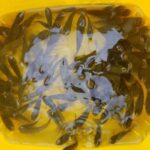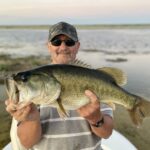The walleye, known for its fierce bite and melt-in-your-mouth taste, has become one of the most popular game fishing species in North America.
As temperatures drop, and the cold weather approaches, hard-water anglers will be preparing for the winter walleye, ice fishing season.
Below, I am going to reveal my 6 must-know tips for ice fishing walleye at night and will show you why nighttime, is the right time, for walleye!
Table of Contents
Why is the Walleye Bite So Good at Night?
Many new anglers don’t understand how to use the nighttime to their advantage when targeting walleyes. While most anglers drift off to sleep, walleye fishermen are just gearing up for the night-shift bite.
Although fishermen can catch walleye all day long, the bite really hits its peak during low light periods, right around sunrise and sunset. This is also known as the ‘night bite.’
Walleye have special eyes that work very well in low-light conditions and unlike other fish like perch, bass, pike, and bluegills, walleye are very good at seeing in the dark.
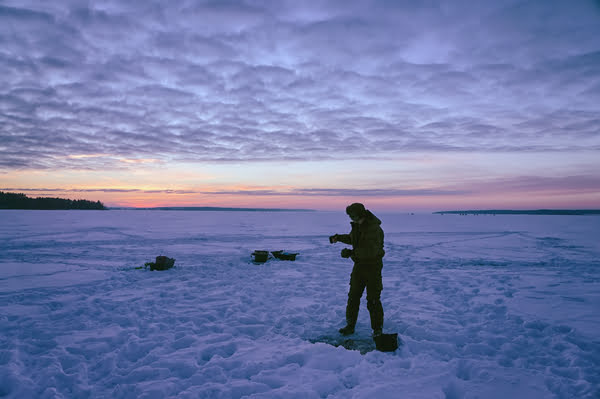
Furthermore, since walleye are a crepuscular or nocturnal species, they tend to feed more at night than other fish.
Chances are if you’re fishing with the correct gear (such as specific walleye ice fishing rods), using the right techniques, and fishing at the correct time, you will have a good chance of landing a walleye.
There are numerous strategies for catching walleye at night. Below are my top tips to increase your chances of getting a big fat golden walleye this winter!
How To Find Good Walleye Fishing Spots
Before you go ice fishing for walleye at night, it is always smart to target good structures and determine what depths are producing fish. Things I look for are submerged structures, buoys, weeds, or rocky shorelines.
During the open water season, walleye like to congregate near weed beds. This is because vegetation entices smaller baitfish, like minnows and yellow perch, which make up the majority of their diet.
Under the cloak of darkness, walleye will emerge from the depths to feed along shallow weed beds or flats. Similar to pike, walleye will hide in these weed beds, waiting to ambush their prey.
Determining The Ideal Depth For Walleye
In order to determine the right depth for walleye, it is important to know what part of winter you are in. Depth will vary daily as winter progresses based on light conditions, feeding behaviors, and the body of water you are fishing.
A good depth to look for while ice fishing for walleye at night is 10 to 20 feet of water. Walleye usually move to shallower water at night in search of bait fish, and that is where you can ambush them.
You don’t just want to set your tip-ups out in one depth, you should spread them out and space them out in a variety of depths, both in deeper and shallower areas. I like to put mine as shallow as 7 to 8 feet if I am not getting any bites.
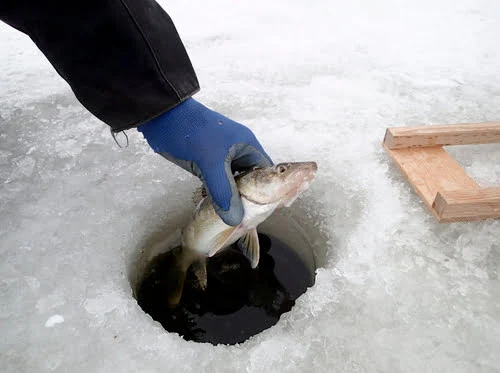
During early winter, walleye can even be found as shallow as 4 feet, since this is where a lot of their prey like to feed.
But as winter progresses and the water gets colder, walleye move into deeper water. In mid-winter, they are often found in basins that are 30-40 feet deep during the daylight hours and move to shallower water at night to feed.
During late winter, walleye can be found at depths between 10-25 feet, around shallow structures, such as underwater hills or mud flats. Typically these areas are close to or near spawning sites.
Fishing During Prime-Time
Many experienced ice anglers don’t call it “golden hour” for nothing. The best time to fish is about an hour before sunset to two hours after sunset, when walleyes are most active and generally are feeding more!
Cloudy days and stable weather are ideal conditions for fishing walleye at night.
Snow atop the ice allows for less light to reach underneath, and one of my favorite bite windows is during an approaching snowstorm!
Setting up your Tip-Ups Correctly
Setting your tip-ups up correctly is very important and can be the difference between having a good night or a bad night.
Tip-ups are an important tool for nighttime walleye missions, due to the fact that you can place them on various different structural elements surrounding your base camp.
You have to rig your tip-ups for walleye differently than how you would for pike. You need to have at least a 4 to 5-foot fluorocarbon leader. Using a fluorocarbon leader will multiply your success rate tenfold, especially when fishing in clear water.
Another strategy whilst using tip-ups is mixing up the size and type of bait fish such as shiners, suckers, and fatheads.
A small addition to add even more flash is hooking the bait fish with fluorescent hooks or spoons to add additional flash to the presentation, which helps while fishing at night.
A problem people often face when using bigger minnows is the minnow setting off your tip up. You can address this problem by snipping off a part of its tail, allowing the minnow to just wiggle in one place.
An advantage of using tip-ups is that you can cover a lot of water and know when and where the fish are moving depending on what lines go off.
Keeping Noise to a Minimum
Keeping noise to a minimum is important when targeting any species whilst ice fishing. Especially when there is snow on the ground, the crunching of your boats or your vehicle can scare away fish, especially in shallow water and on thin ice.
Another way to prevent scarring away fish is to complete your hole drilling an hour before prime time.
I’d recommend drilling at least a dozen holes scattered across different structures such as a point, rock pile, or transition.
Use Bright and Loud Lures
Low light conditions call for bright and loud lures and baits. Luckily glow-in-the-dark lures are available in many different shapes and sizes for different applications.
Rattling lures are also a good option when targeting walleyes at night. Even if the walleyes don’t bite your rattling bait, it will at least draw them into your line of tip-ups.
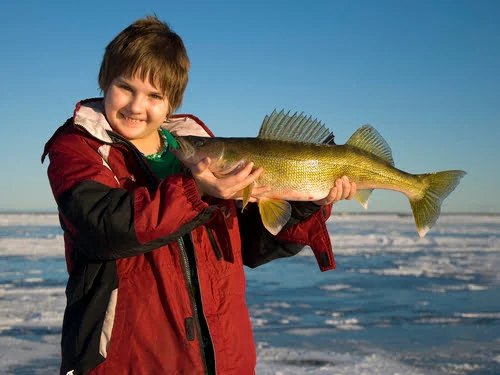
Spoons are also a great thing to use when targeting walleyes at night, and many people even put spoons on their tip-ups to add additional flash. Jigging spoons nowadays even incorporate rattles in them!
Have Adequate Lighting
Having good lighting while fishing at night should be common sense but is often a missed element. Having headlights as well as attachable lights equipped on your tip-ups is essential for seeing when your set lines go off and making sure they stay visible.
It is also important to remember to bring spare batteries for your different light sources depending on how long you plan to stay out on the ice.
Conclusion
In conclusion, walleye fishing can be difficult, but not impossible if you stick to the 6 steps listed above!
Following this guide is guaranteed to give you a competitive edge over other ice anglers and walleyes.
You May Also Like: Tips for Ice Fishing For Crappie At Night
If you haven’t guessed yet, I love fishing and everything about it!
To learn more about why I started Panfish Nation, visit the About page and follow along on Social Media:


Download a copy of my FREE Lure Color Selection Chart & Knot Guide!
Stay up to date with fishing reports, tackle reviews, industry news, and much more! We respect your privacy, unsubscribe at any time.

